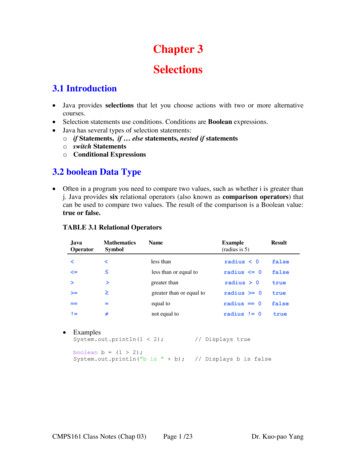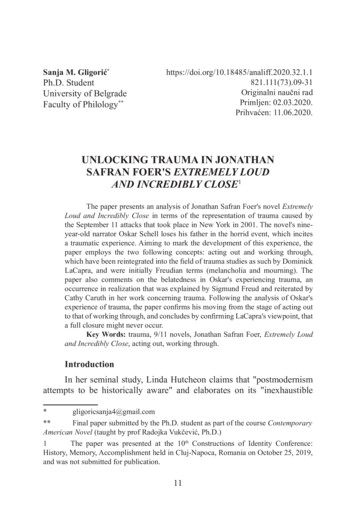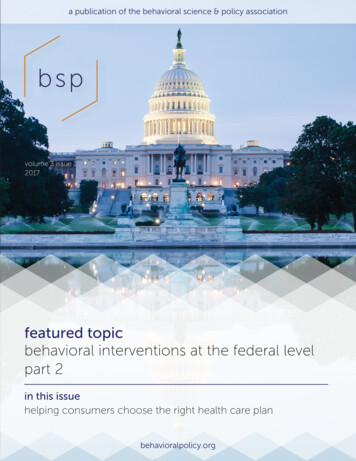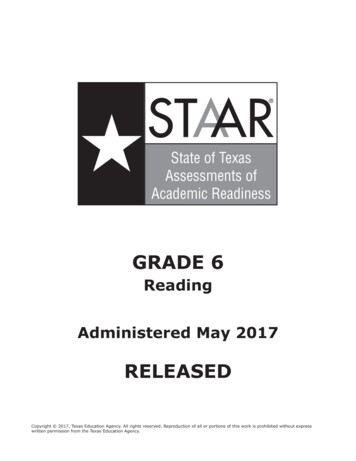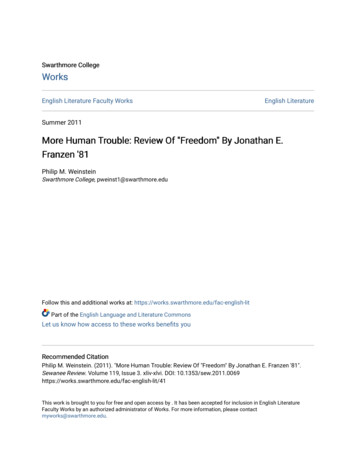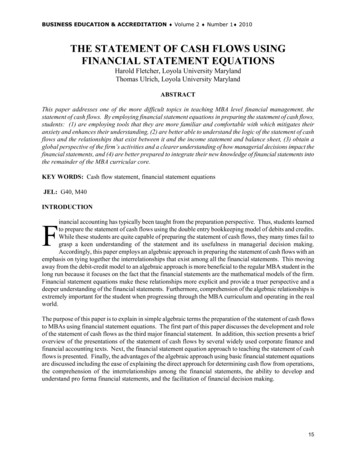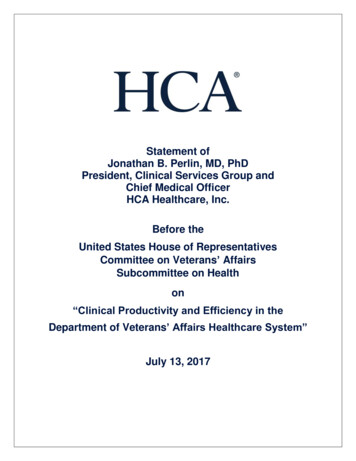
Transcription
Statement ofJonathan B. Perlin, MD, PhDPresident, Clinical Services Group andChief Medical OfficerHCA Healthcare, Inc.Before theUnited States House of RepresentativesCommittee on Veterans’ AffairsSubcommittee on Healthon“Clinical Productivity and Efficiency in theDepartment of Veterans’ Affairs Healthcare System”July 13, 2017
United States House of Representatives Committee on Veterans’ Affairs Subcommittee on HealthJuly 13, 2017 2PM Cannon House Office Building, Room 334Statement by Jonathan B. Perlin, MD, PhD,President, Clinical Services Group and Chief Medical Officer, HCA HealthcareGood afternoon. I’m Dr. Jonathan Perlin, President of Clinical Services and Chief Medical Officer for Nashville,Tennessee-based HCA Healthcare. I would like to thank Committee Chairman Roe, Subcommittee ChairWenstrup, ranking member Brownley, and members of the Subcommittee for this opportunity to comment onVHA Clinical Productivity and Efficiency.We are the nation’s largest private healthcare provider, and have the privilege of caring for patients through28 million clinical encounters annually. These include approximately 1.65 million hospitalizations, 8.5 millionemergency room visits, and more than 220,000 deliveries. We number about 241,000 employees, of whomapproximately 80,000 are nurses. These numbers are exclusive of nearly 37,000 voluntary physicians. We seepatients at 168 hospitals and more than 1,200 other sites of care, including surgical centers, free-standingemergency rooms, urgent care, and physician offices across 42 markets in 21 states. In other words, we aresimilarly-sized to the Veterans Health Administration.We are proud to acknowledge that included in our dedicated healthcare workforce are many Veterans andmilitary spouses. We invest in employing service members, and in 2016 alone, we hired more than 5,400military Veterans and 1,100 military spouses. In 2015, the U.S. Chamber of Commerce Foundation awardedHCA the “Hiring Our Heroes Lee Anderson Veteran and Military Spouse Employment Award.”I believe that I have a unique perspective to offer the Committee, having served as Chief Quality Officer,Deputy Under Secretary and Under Secretary for Health, as well as – like the Secretary, Dr. Shulkin – as a VAphysician during my tenure in these roles.I appreciate the opportunity to support the work of the Committee and the Department in providing the mosteffective and efficient care for America’s Veterans. In his 100-day briefing at the White House, SecretaryShulkin offered 13 observations on areas he considered risks for VA. He and his team came to theseconclusions from both a business and clinical perspective. While there is no need for me to recount themhere, a few are worth noting, as they are directly responsive to some of the concerns that the GAO reportidentifies. I will augment his observations with mine, bringing current private-sector perspective on how wemanage productivity within our organization.Dr. Shulkin’s first diagnosis of risk concerned access. I will not recount all of the statistics, but would note thathis comments identify substantial progress overall, increased same-day access for primary and certainspecialty services and some remaining opportunities for improvement. Obviously, increases in providerefficiency are an important means for creating additional capacity and access.The second area of concern involves prompt payment of external providers. This is an area in which legislativerelief would be helpful. Consolidation of disparate models for obtaining services outside of VA and, frankly,comportment with Medicare or private insurer reimbursement models would facilitate provider participationand Veteran access to services. The complexity of the different models imposes statutory inefficiencies in VA’soverall management of care within and outside of VA.2
United States House of Representatives Committee on Veterans’ Affairs Subcommittee on HealthJuly 13, 2017 2PM Cannon House Office Building, Room 334Statement by Jonathan B. Perlin, MD, PhD,President, Clinical Services Group and Chief Medical Officer, HCA HealthcareThe third area noted by Dr. Shulkin was quality. VA is to be commended for making their star ratings public.VA is increasingly benchmarking against private sector, and in many instances, VA performance is as good, ifnot better. I note these areas because they are salient to GAO’s central observations on VA providerproductivity.GAO first notes that “Productivity metrics are not complete because they do not account for allproviders or clinical services.” Secretary Shulkin’s recent expansion of scope-of-practice for advancedpractitioners will both increase productivity and present an increasing challenge in recording andbenchmarking productivity. Indeed, VA is apt to become the reference point for advanced practitionerproductivity, to the extent that data systems can attribute the work performed to advanced practitionersindividually or in the aggregate.GAO further notes that “metrics do not capture providers’ workload evaluating and managinghospitalized patients.” This is a challenge for all entities that provide team-based care. The attribution ofworkload to certain members of the team, beyond the attending physician, is notoriously complex, as hasbeen demonstrated in long-standing debate regarding attribution of quality and safety metrics. This isdemonstrated by, for example, contention over who receives credit for a positive quality outcome (forexample, a care episode without a vascular catheter infection) or blame for a safety breach (for example, ahospital-acquired infection). This is problematic because many hands touch the patient, and data systemsdon’t capture every touch. While data systems could be designed for attribution of effort, workload needs tobe captured as a by-product of work, otherwise it would be inefficient, requiring providers to spend as muchtime designating their work, as doing their work.GAO’s next observation that “Productivity metrics may not accurately reflect the intensity of clinicalworkload” has roots to some degree in the same phenomenon – does extra effort required for codingworkload compete with actual work and productivity? On the other hand, as VA has announced the decisionto re-platform its electronic record, this would be an ideal time to consider how to embed tracers of workflowthat can transparently capture productivity. I would note that in our organization, when we think about thecare of hospitalized patients, rather trying to capture every individual’s action, we summarize by looking at“employee equivalents per occupied bed.”The GAO Report further notes that “A 2016 VA audit shows that VA providers do not always accuratelycode the intensity of . . . clinical procedures or services. As a result, VA’s productivity metrics may notaccurately reflect provider productivity, as differences between providers may represent coding inaccuraciesrather than true productivity differences.” Again, documentation improvement to capture the patient’sservice intensity requirement is something that private sector has become highly proficient in doing, as it issimultaneously the basis for clinical risk adjustment, as well as the basis for graduated payment levels.Similarly, this – and “recording (clinician) time performing clinical duties” – are area that VA’s new electronichealth record should assist with improving.3
United States House of Representatives Committee on Veterans’ Affairs Subcommittee on HealthJuly 13, 2017 2PM Cannon House Office Building, Room 334Statement by Jonathan B. Perlin, MD, PhD,President, Clinical Services Group and Chief Medical Officer, HCA HealthcareI would agree prima facie with the statement that “efficiency models may also be adversely affected byinaccurate workload and staffing data” and that the impact may lead to either understating or overstatingefficiency.On the basis of my experience with VA management systems of more than a decade ago, as well as myresearch in preparing for this hearing, I would also agree with GAO’s finding “that VA Central Office has takensteps to help VAMCs monitor provider productivity by developing a comprehensive analytical tool VAMCs canuse to identify the drivers of low productivity.”GAO’s exhortation to “systematically oversee VAMCs’ efforts to monitor clinical productivity andefficiency . . . and systematically identify best practices to address low productivity and inefficiency” is acentral challenge for management of multi-facility health systems across the United States. Certainly, it is acentral focus for our organization and, in this regard, VA and HCA share an operating advantage: Both systemsare large enough to look for positive variation. If the underpinnings of better performance can be understood,replicated and scaled, it becomes the means to elevate the performance of the entire system.Understanding variation within the system and comparison with external performance standards iswhy both internal and external benchmarking are necessary: Internal benchmarking allows systems to tap intothe data that they have to identify both positive and negative variation. Internal benchmarking is a tool forlearning and management. It can function as one part of a control system for facility, VISN and VACOleadership to manage performance. External benchmarking is necessary to understand whether internalperformance is superior, consistent with or inferior to external organizations. External benchmarking is limitedby differences in data availability and data definitions among organizations.VA’s “SAIL” system provides elements for both internal and external benchmarking, and I would againagree with GAO’s assessment that this is a useful management tool for all of the reasons I’ve noted.I would note that the biggest challenges to external benchmarking are not related to data, but rather certaininherent features of VA and the patients it serves:First, Veterans using VA are systematically more complex patients than commercially-insured or even mixedcommercial/government-covered (i.e., general Medicare or Medicaid) populations. So, some of the externalreferences, such as the MGMA (Medical Group Management Association) benchmarks may need to betempered. Better reference environments may be safety net providers, in terms of patient complexity, as wellas academic health systems that – like VA – have a simultaneous teaching responsibility.Second, the VA benefits package is systematically different that either commercial insurance or othergovernment programs, like Medicare or Medicaid. VA’s breadth of services means that there are more thingsthat a provider can, should and must do during a clinical encounter. In a capitated system, it is rational to takeall necessary actions for preventive services or other interventions that reduce the need for future services orsubsequent interventions. Again, the tension between work and recording work arises.4
United States House of Representatives Committee on Veterans’ Affairs Subcommittee on HealthJuly 13, 2017 2PM Cannon House Office Building, Room 334Statement by Jonathan B. Perlin, MD, PhD,President, Clinical Services Group and Chief Medical Officer, HCA HealthcareThird, RVU’s were developed for fee-for-service environments and, as such, are intended to make providercompensation proportional to recorded effort. This obviously incentivizes both work and the recording ofwork. Private sector enjoys different flexibility in provider compensation models, so when clinicians areemployed by a provider organization, provider compensation can be calibrated to productivity. In ourorganization, we always look at productivity, compensation and quality together. While provider performanceon quality is a non-negotiable expectation, we can calibrate compensation appropriately.Fourth, in our organization, our physical plants and adjunctive staffing models are oriented to enhancingproductivity. It is systematically inefficient for a clinical provider to operate from only one or two exam roomsand with one or fewer support staff. My understanding is that despite some spectacular new facilities, VA stillhas opportunity to improve its aged plants and associated staffing models.Fifth, there may be times when it is inefficient or inappropriate for VA to internally produce all of the careVeterans need. I agree with the Secretary’s perspective to use private sector services when geographic access,wait times, capacity, demonstrated clinical performance excellence or technology are not available in VA.On the other hand, VA has demonstrated excellence in serving as a medical and health home for the mostcomplex of patients. Indeed, many Veterans using VA are patients with multiple medical and social challenges– such as serious mental illness, advanced physical illness, poverty and other vulnerabilities directly related totheir statutory eligibility for VA care – that challenge private-sector performance and distinguish VA. Thatcontinuity-of-care and coordination of services (including medical and social) that VA provides is not onlyspecial, but not directly replicable in private sector.Finally, and in closing, it is obligatory to look at productivity and quality simultaneously. Quality and safety arealways most efficient: rework for breaches in either is neither efficient, nor consistent with the performanceexcellence that taxpayers deserve and that Veterans should expect and have earned through their service andsacrifice. Again, my thanks to the Subcommittee for this opportunity, and we look forward to working withyou and Secretary Shulkin to accomplish these objectives.-END-5
July 13, 2017 2PM Cannon House Office Building, Room 334 Statement by Jonathan B. Perlin, MD, PhD, President, Clinical Services Group and Chief Medical Officer, HCA Healthcare 3 . example, a care episode without a vascular catheter infection) or blame for a safety breach (for example, a hospital-acquired infection). This is problematic .
